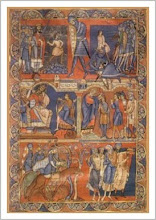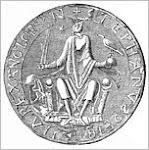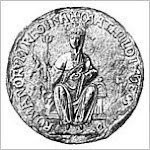Of the two, Stephen's legacy was more obsure, via his daughter Mary (Marie) and his connection to Philippa of Hainault, the wife of Edward III, while Matilda's was direct and obvious, via her son Henry II. After his coronation Matilda continued to act as Regent in Normandy during his absences and Charters were issued in both of their names. For his own part Henry, in addition to all of the lands and titles he already held, managed to gain a foothold in Ireland. How did this happen?
Although I'm going off on a tangent and diverging from the original intent of the blog somewhat, the events of this period represent an important convergence point in the histories of England, Wales, and Ireland, and I think it's a story worth telling.
As mentioned in the blog entry "Stephen and the Welsh", Henry conducted largely successful campaigns in Wales in 1157, 63, and 65, and the Norman presence was fairly well established despite various rumblings and revolts. And what has this to do with Ireland you ask? Well ...
Ferns (Fearna) is a small historic town in the north of County Wexford and much of the history of modern Ireland begins here. It was the base of Diarmait Mac Murchada, King of Leinster, who appealed to Henry II of England for aid after he was ousted from his lands by Tairrdelbach mac Ruaidri Ua Conchobair, the High King of Eire, in 1166. Diarmait fled first to Wales and then followed Henry to Aquitaine to seek his support and consent to recruit soldiers. For Henry, who had first given thought to an invasion of Ireland soon after his coronation*, it was an opportunity too good to pass up. He agreed to help Diarmait reassert control in Leinster and eventually made men, knights, and nobles available for this purpose.
By 1167 Diarmait had obtained the services of Maurice Fitz Gerald and the first Norman knight, Richard Fitz Godbert de Roche, landed in Ireland in that year. In 1168 after several appeals to Rhys ap Gruffydd, the Prince of Deheubarth, Diarmait secured the release Fitz Gerald's half-brother Robert Fitz-Stephen from captivity so that he could also take part in the Irish campaign. Fitz-Stephen helped Diarmait organise a mercenary army of Norman and Welsh soldiers. In something of a coup Diarmait also obtained the support of Richard de Clare, the Earl of Pembroke, nicknamed Strongbow*.
In May 1169 the main body of Norman and Welsh forces landed in Wexford near Bannow strand. After a two day siege during which all the ships in the town's harbour were burnt, the defenders sent envoys to Diarmait. A bishop (or maybe two) in the town had persuaded them to surrender. The defenders renewed their allegiance to him and the Siege of Wexford was over.
Not content with this victory Mac Murchada sought vengeance for past ills, assembled an army, and prepared to march towards Dublin. His ambitious plans apparently also included eventually marching on Tara. Over-reaching himself Diarmait lost a battle and had to retreat. Strongbow had not been in the initial invasion force and after appeals from Diarmait, who was facing new threats to his position, he finally arrived in Ireland in August 1170. Within a short time Leinster was settled and Waterford and Dublin were under Diarmait's control. Strongbow’s support came at a price though and in exchange for his loyalty Diarmait offered Richard his daughter Aoife in marriage, to which she agreed, and made him heir to his kingdom.
Of far greater consequence though was the fact that Diarmait had, by his appeals for help, invited the Normans to invade Ireland.
Henry II had kept a watchful eye on these events. He grew concerned that Strongbow and his supporters would become independent from him and perhaps even establish of a rival Norman state in Ireland. In 1171 Henry arrived in Leinster with an army in order to establish his authority. He stayed for six months and declared himself Lord of Ireland. During this time many Irish princes and all of the Normans took oaths of homage to him. In 1177 he named his youngest son, John, Lord of Ireland. The domination of Ireland by the English had begun.
Matilda, The Empress, of course had not lived to see the outcome of her son's ambitions in Ireland but in an interesting footnote she had opposed Henry's original plan. (see notes below)
Notes:
* Soon after his coronation in 1154 Henry had sent an embassy to Pope Adrian IV led by Bishop Arnold of Lisieux. The group of clerics requested authorisation for Henry to invade Ireland. Some historians suggest that this resulted in the issue of the papal bull Laudabiliter in 1155, although the authenticity of this has been questioned. Henry may have acted under the influence of a plot in which English clerics sought to dominate the Irish church, perhaps he was simply ambitious and greedy for more, or it’s possible that he may have intended to secure Ireland as a lordship for his younger brother William who died soon after the plan was devised. Whatever the case may be, any plans for Ireland that Henry may have had were laid aside at this time.
* To his contemporaries Richard de Clare, Strongbow, was known as Earl of Striguil
* Maurice Fitz Gerald had fought at the Battle of Crug Mawr in 1136 (again see the post Stephen and the Welsh for more information)
* More About Robert Fitz-Stephen:
Robert Fitz-Stephen was the illegitimate son of Stephen, Constable of Cardigan. His mother was Nest ferch Rhys, a Welsh princess of Deheubarth renowned for her beauty. Robert succeeded his father in the office of Custos Campe Aberteifi and first appears in history in 1157. That year Henry II invaded Gwynedd and while the main army faced the forces of Owain east of the River Conwy another force, which included Robert and his half-brother Henry Fitzroy, attacked Anglesey by sea. This force was defeated in battle. Robert was wounded and his half-brother killed.
Robert pops up again when he was captured by Rhys ap Gruffydd in 1165. He was released after appeals by Diarmait, King of Leinster, the first in 1167 and again in 1168.
As already mentioned Robert Fitz-Stephen helped organise an army for Diarmait and in May 1169 led the vanguard of Welsh-Norman auxiliaries to Ireland with a force of 30 knights, 60 men-at-arms and 300 archers. Maurice Fitz Gerald landed at the same bay with 10 knights and 60 archers the next day. This force merged with about 500 soldiers commanded by Diarmait. After their victory at the Siege of Wexford, Mac Murchada granted Fitz-Stephen and Fitz Gerald a share in two cantreds, Bargy and Forth. This comprised all the land between Bannow and the town of Wexford.
From the writing of Giraldus Cambrensis (Gerald of Wales or Gerald de Barri):
"Mac Murchard was much delighted and encouraged by the tidings of this new arrival, and calling to mind, with the desire of vengeance, the deep injuries which the people of Dublin had done both to his father and himself, he assembled an army and prepared to march towards Dublin. In the meantime, Fitz-Stephen was building a fort upon a steep rock, commonly called the Karrec, situated about two miles from Wexford, a place strong by nature, but which art made still stronger."
Robert received a further grant for services rendered in 1177 - the kingdom of Cork from Lismore to the sea with the exception of the city of Cork. This one was made by Henry II and shared jointly with Miles de Cogan. However things did not go quite so smoothly this time. The Irish princes disputed the king's right to dispose of the territory, arguing that they had not resisted the king or committed any act that justified the forfeiture of their lands. Consequently, Fitz-Stephen was nearly overwhelmed by a rising in the Kingdom of Desmond in 1182 and experienced great difficulty in maintaining his position. Philip de Barri, the second son of his half-sister Angharad, came to Ireland in 1185 and together with yet another relative, Raymond FitzGerald (Raymond Le Gros), they recovered the lands and reached a compromise agreement. The barons held seven cantreds near Cork while the remaining twenty four were retained by the Irish princes. Fitz-Stephen would eventually cede these territories to Philip de Barri as he had no living male heirs. The date of his death is uncertain.
Notes:
Oh, what a tangled web this family weaves!
Henry Fitzroy was the illegitimate son of Nest and King Henry I
Rhys ap Gruffydd was the nephew of Robert’s mother Nest
Nest was also the mother of Maurice and Angharad
Robert de Barri was present at the Siege of Wexford. He was the eldest son of Robert’s half-sister Angharad
Miles de Cogan was the son of Robert’s half-sister Gwladys
10 August 2011
Subscribe to:
Post Comments (Atom)








No comments:
Post a Comment